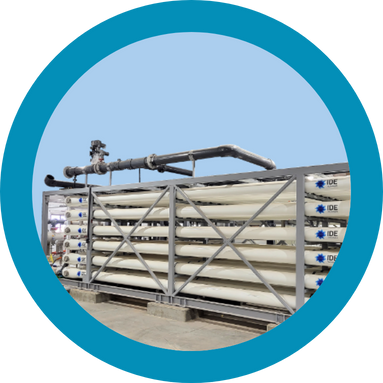MUNICIPAL WASTEWATER REUSE
Advanced wastewater solutions for sustainable water management

Reusing municipal wastewater is a necessary way to address the world’s growing water demand.
At IDE, we offer advanced solutions for potable reuse that comply with and exceed environmental and regulatory requirements.
Municipal wastewater treatment involves preliminary, primary and secondary treatment. In some cases, advanced treatment is needed for potable reuse purposes, either IPR or DPR.
FAT (Fully Advanced Treatment)
FAT is the common design configuration for municipal wastewater potable reuse facilities which incorporates the 3-barrier treatment
The treatment, which is common in the United States, uses an additional step of treatment to the TTRO and includes three stages; UF/MF, standard multi-stage RO, and UV/AOP. UV AOP, the process of using ultraviolet light with an oxidant to break down environmental contaminants in water, is an essential part of the potable reuse treatment scheme.
IDE offers these two FAT solutions:
FAT with RO
A modular traditional three stages RO with standard recovery rates.
FAT with PFRO which delivers:
High recovery rate & high flux solution
High fouling and biofouling resistance
Cleaning In Operation & recycling chemical wash water
High availability
Chloramine free
Simplified single stage small footprint design
PFRO (Pulse Flow Reverse Osmosis)
Conventional RO operates in stable hydraulic and osmotic conditions, increasing the tendency for scaling and fouling. In addition, these stable conditions enable microorganisms to thrive on the RO membranes and thus form biofouling. IDE Technologies’ proprietary Pulse Flow Reverse Osmosis (PFRO) technology utilizes mechanical and chemical techniques to solve these common RO challenges. It does so by constantly changing the flow regime and the osmotic and hydraulic pressure. As a result, the PFRO system enables an increase in water recovery rate without increasing membrane cleanings or replacements.
How does it work?
Each cycle of PFRO includes two modes: production and flushing. During the production mode, the brine valve is closed, and there is no brine discharge, which means that 100% of the feed flow is passing to the permeate side. During the flushing mode, the brine valve opens for a short period of time, enabling brine to discharge at a high velocity. This creates short and rapid pulses with a high shear force that helps keep the membranes free from fouling.
The result?
PFRO simplifies RO design by utilizing a single-stage configuration for high recovery municipal potable reuse of up to 90% while overcoming the scaling and biofouling challenges with no use of chloramines and leading to CAPEX savings of up to 20%.
The common FAT configuration for potable reuse typically includes a dosage of chloramine, which helps control biofouling of the membranes but may also generate disinfection byproducts such as NDMA – a dangerous organic contaminant and a suspected carcinogen. The PFRO eliminated the need for the use of chloramine, thus ensuring a safer process.
Technology Advantages of IDE PFRO
HIGH RECOVERY RATES – 90% recovery and higher.
SIMPLE DESIGN AND MAINTENANCE – Single-stage design, less piping, no interstate boosters.
REDUCED SCALING AND BIOFOULING & INCREASED AVAILABILITY – by implementing the PFRO unique CIO (clean in operation) concept, the membranes are maintained clean and the CIP frequency significantly decreases.
SAFER – Chloramine free no formation of harmful disinfection by-products.
COST EFFICIENT – Optimized (13) CAPEX is enabled thanks to higher flux RO operation and simplified one-stage design.
TTRO (Tertiary Treatment Reverse Osmosis)
Tertiary Treatment RO refers to the process of using reverse osmosis (RO) technology after the tertiary treatment stage of wastewater treatment.
Tertiary treatment is the final stage of wastewater treatment, following primary and secondary treatment. Its primary objective is to remove any remaining stubborn contaminants from the water that were not removed by the previous stages before it is discharged into the environment or reused.
Tertiary treatment usually involves advanced treatment processes such as filtration, disinfection, membrane filtration, reverse osmosis, activated carbon adsorption, and chemical precipitation. These processes remove any remaining suspended solids, organic matter, nutrients, and pathogens from the water.
Tertiary treatment using RO technology has become increasingly popular as a method of producing high-quality treated water for reuse. It can effectively remove a wide range of contaminants from the water, including pathogens, heavy metals, and organic pollutants. RO technology is also known for its efficiency and low energy consumption, making it a cost-effective option for producing high-quality water.
Tertiary treatment is an important part of municipal wastewater treatment as it helps to protect public health and the environment by ensuring that treated water is safe and free from contaminants.
Contact an IDE Expert
Would you like more information about our technologically advanced solutions?










